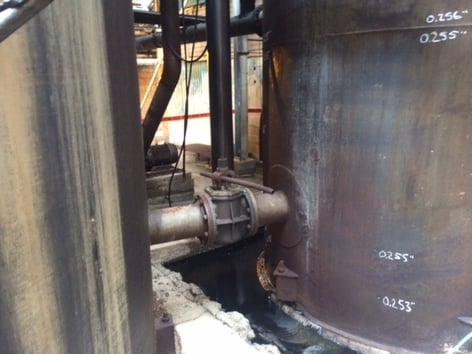The Important Role of Tank Welding Inspection in Ensuring Structural Honesty and Safety And Security Conformity in Industrial Applications
In the world of industrial applications, storage tank welding evaluation emerges as a pivotal component in guarding architectural stability and guaranteeing compliance with safety laws. Making use of a mix of techniques such as visual evaluations and advanced screening approaches, these evaluations serve to recognize and alleviate prospective problems before they rise into substantial dangers. The effects of these methods expand beyond simple governing adherence; they essentially impact functional effectiveness and asset long life. The complexities bordering the evaluation procedure trigger a closer examination of its methods and outcomes, exposing layers of importance that merit additional exploration.
Significance of Storage Tank Welding Examination

Ensuring compliance with market requirements and guidelines is an additional considerable element of tank welding inspection. Governing bodies mandate stringent standards for the building and upkeep of tank, and complete examinations aid organizations stick to these needs. Non-compliance can result in severe penalties, including fines and shutdowns, even more highlighting the need for rigorous assessment procedures.
Moreover, tank welding inspection plays an essential role in keeping functional effectiveness. Routine assessments can identify potential concerns prior to they escalate, promoting timely repairs and lessening downtime. This proactive approach not just boosts security but also adds to cost financial savings over time. In recap, the significance of tank welding examination exists in its capability to safeguard public health and wellness, protect the atmosphere, and make sure compliance with regulatory structures.
Key Assessment Techniques
Effective container welding inspection relies on a range of vital methods that make sure comprehensive examination of weld quality and structural stability. Amongst one of the most prevalent methods are aesthetic inspection, ultrasonic testing, radiographic screening, and magnetic fragment testing - Tank Welding Inspection. Each method uses special benefits in examining different aspects of the weld
Visual assessment offers as the first line of defense, enabling examiners to determine surface area issues, abnormalities, or inconsistencies in the weld bead. Ultrasonic testing utilizes high-frequency audio waves to identify internal defects, such as fractures or voids, offering a detailed evaluation of weld honesty. This approach is specifically reliable in detecting issues that may not be visible on the surface.
Radiographic testing uses X-rays or gamma rays to create pictures of the welds, exposing interior interruptions and giving a permanent record for future referral. additional info This technique is extremely reliable for essential applications where the threat of failure must be minimized.
Finally, magnetic bit testing is employed to identify surface and near-surface issues in ferromagnetic products. By using electromagnetic fields and fine iron particles, inspectors can pinpoint discontinuities that might endanger the architectural integrity of the container. Together, these strategies develop a robust framework for ensuring high-quality welds in commercial applications.
Conformity With Security Criteria

Regular examinations play a critical duty in ensuring conformity by identifying possible failures or deviations from recommended standards. Assessors are trained to examine weld quality, verify material specifications, and examine the overall architectural integrity of storage tanks. Their competence is vital in making sure that welding procedures satisfy the called for security standards.
In addition, compliance with security criteria not only secures workers however additionally safeguards the setting from possible dangers such as leakages or devastating failings. Organizations that prioritize security conformity are much better positioned to alleviate threats, enhance operational performance, and foster a culture of security within their labor force. In recap, maintaining extensive conformity with safety and security standards is vital for the effective operation of tank welding activities in commercial setups.
Advantages of Regular Evaluations
Routine assessments are my review here indispensable to maintaining the structural stability and security of bonded containers. These examinations provide a systematic method to determining possible issues or weak points in the welds, ensuring that any problems are resolved before they rise right into significant failings. By carrying out normal evaluations, organizations can identify deterioration, exhaustion, and various other kinds of degeneration that might endanger storage tank efficiency.
Additionally, constant assessments add to compliance with industry policies and standards. Abiding by these standards not just minimizes lawful dangers yet likewise enhances the organization's reputation for safety and security and integrity. Normal assessments promote a proactive safety society, urging workers to acknowledge and prioritize the relevance of tools stability.

Study and Real-World Applications
Situation researches and real-world applications illustrate the concrete influence of efficient container welding inspection methods. Adhering to the implementation of extensive welding examination protocols, including aesthetic and ultrasonic screening, the facility determined essential flaws in weld seams that can have led to catastrophic failures.
Likewise, a water therapy plant applied an extensive assessment program for its container welding procedures - Tank Welding Inspection. By incorporating non-destructive testing techniques, the plant had the ability to identify early signs of rust and tiredness in weld joints. This prompt treatment expanded the life-span of the tanks and guaranteed compliance with security guidelines, hence guarding public wellness
These case studies underscore the significance of routine and methodical storage tank welding assessments. By focusing on these methods, industries can reduce threats, improve architectural honesty, and ensure compliance with security standards, ultimately resulting in boosted operational effectiveness and lowered responsibilities.

Conclusion
In conclusion, container welding evaluation is an indispensable element of maintaining architectural honesty and security in commercial applications. Utilizing numerous evaluation strategies guarantees very early detection of prospective flaws, consequently protecting against devastating failures.